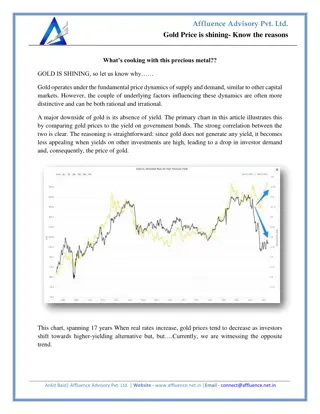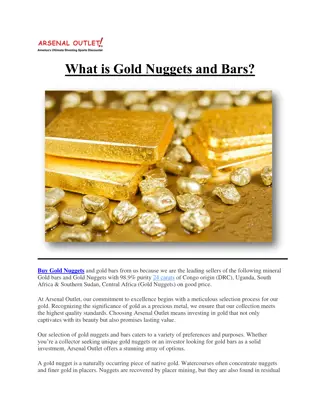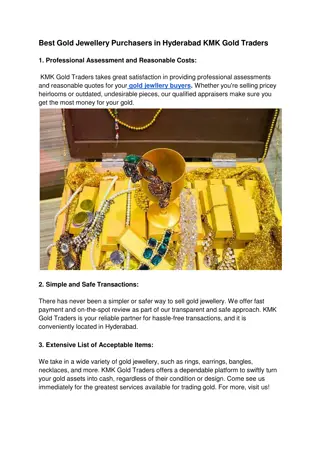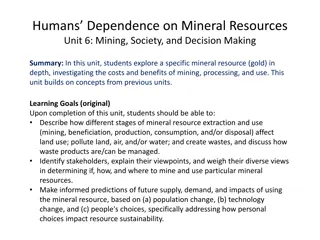Gold and Silver Market Dynamics
The price of gold and silver experienced significant fluctuations during the Great Recession, influenced by monetary inflation and economic prosperity. Explore the historic significance of measuring systems and the emergence of modern market architects like the Rothschilds.
Download Presentation

Please find below an Image/Link to download the presentation.
The content on the website is provided AS IS for your information and personal use only. It may not be sold, licensed, or shared on other websites without obtaining consent from the author.If you encounter any issues during the download, it is possible that the publisher has removed the file from their server.
You are allowed to download the files provided on this website for personal or commercial use, subject to the condition that they are used lawfully. All files are the property of their respective owners.
The content on the website is provided AS IS for your information and personal use only. It may not be sold, licensed, or shared on other websites without obtaining consent from the author.
E N D
Presentation Transcript
Making Modern Markets Xiao Wang
Silver and Gold in Mexico and Brazil Silver and Gold in Mexico and Brazil The price of gold roughly tripled between the start of the Great Recession in 2007and 2011; that of silver more than quadrupled.
From a traditional perspective, gold prices can reflect monetary inflation, which is the inflation of money supply. Since the reserve banking system under the U.S. Federal Reserve System is inherently inflationary, the total amount of money in circulation is always prone to expansion, and it is sometimes sharp. If monetary inflation exceeds the actual growth of products and services, the result will be price inflation, which is measured by the government through the consumer price index (CPI) and the production price index (PPI). The year-to-year changes in the balance between supply and demand for gold are relatively small, so the price change over the decade is due to inflation. Since inflation is usually accompanied by economic prosperity, gold price growth is sometimes consistent with a strong economy.
The Metric Revolution Measurements are the result of historic processes, social struggles, and conceptual revolutions. Most measures have been anthropomorphic. People measured with their arms (the fathom), their hands (span), their feet (feet), and their elbows (the el). They also measured according to their strength, sight, or hearing.
The plethora of measuring systems was not simply a result of folk wisdom (or ignorance), however. For thousands of years weights and measures were seen as attributes of justice and sovereignty. Authority meant the power to define the scales. When the definer of measures was also the tax collector and lender, abuse often followed. Under feudalism each lord set his own standards and his court judged them. The definition of measures sometimes varied intentionally to hide price differences. As goods became produced for a distant market, they lost the distinctiveness bestowed by the individual producer or consumer, becoming mass products with common attributes that could be measured.
From Court Bankers to Architects of the Modern World Market: The Rothschilds The rise of the Rothschilds is not always smooth. Now known as the founder of the family, Mayer Rothschild, was the first to engage in currency trading. Since Germany had 350 principals in the late 18th century and each of its principal countries had its own currency system, Mayer s occupation was almost equivalent to foreign exchange. After returning from a well-known family bank in Hannover, Germany, he started his own business in Frankfurt. He not only engaged in ancient coins and antique transactions, but also exchanged gold, silver and banknotes. He became a banker.
After the end of the Franco-Prussian War and the outbreak of the First World War, the Rothschilds became more than a century old. But after the end of World War I (1918), Rothschild quickly disappeared. Their failure to establish a foothold in the US financial market proved to be the main reason for their decline. Many people already know that Rothschild s influence on the world, especially the financial market, has been minimal. The N.M. Rothschild Group is still alive and has branches in 30 countries, including Paris and New York. In 2001, its profit was $134 million. Compared with Citigroup's $21 billion, it is not enough to get in the way. Although the wealth of ordinary people of the Rothschilds family is still difficult to reach, but their several major investment preferences and results throughout the history of the family's rise and fall, but also tells people that the Rothschild family as same as ordinary people will make mistakes.
Grain goes to global Grain was an abstract commodity: something which was represented in particular places by endless varieties of rice, wheat, and other starches, but which could nonetheless be thought of as a single category of things, affecting each other through a loosely integrated global market.
In today's society, grain is no longer merely a food to feed people, but is a commodity that can be hoarded, hyped, and profited. Under the influence of globalization and the neo-liberalism that accompanies it, there are many political and economic commercial interests behind the grain. What a country wants to produce and how consumers choose is no longer a matter of discretion, it is a necessity of the global grain architecture. Crops are no longer designed to meet basic human needs, but to exist in the market and sometimes even for political control.
How Time Got That Way In order to take care of the ease of use of various regions, it also makes it easy for people in other places to convert local time to other places. The relevant international conference decided to divide the Earth's surface from east to west by warp and divide it into regions, and set a time difference of 1 hour between adjacent regions. People at the eastern and western ends of the same area saw the difference in the time at which the sun rose up to a maximum of one hour. When people cross an area, they correct their clock for one hour (one hour westwards and one hour eastwards), plus or minus several hours across several areas. This is very convenient to use. Today, the world is divided into 24 time zones. Since practically one country, or one province, simultaneously spans two or more time zones, one country or one province is often grouped together to facilitate administrative convenience. Therefore, the time zone is not divided strictly according to the north-south straight line, but is divided according to natural conditions.
Cross-time zone trade and finance have achieved seamless convergence and the possibility of continuous 24-hour work. According to financial distribution, the three major time zones are New York, London and Japan. The working hours of these three time zones effectively cover all time periods. When the financial transaction from the first time zone is over, the second time zone can effectively connect and continue with the tasks of the previous time zone. At the end of the second time zone, it is assigned to the third time zone, and when the third time zone ends, the first time zone can already begin to negotiate the tasks of the other two time zones. For speculators and companies with global product R&D, cross-temporal trade is undoubtedly a boon.






















